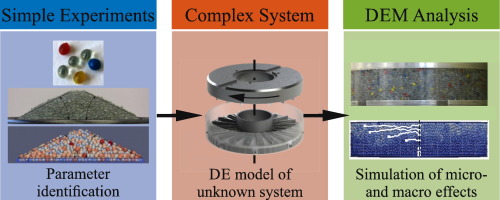当前位置:
X-MOL 学术
›
Powder Technol.
›
论文详情
Our official English website, www.x-mol.net, welcomes your feedback! (Note: you will need to create a separate account there.)
An alternative DEM parameter identification procedure based on experimental investigation: A case study of a ring shear cell
Powder Technology ( IF 5.2 ) Pub Date : 2018-04-01 , DOI: 10.1016/j.powtec.2017.12.072 T. Falke , K.M. de Payrebrune , S. Kirchhof , L. Kühnel , R. Kühnel , T. Mütze , M. Kröger
Powder Technology ( IF 5.2 ) Pub Date : 2018-04-01 , DOI: 10.1016/j.powtec.2017.12.072 T. Falke , K.M. de Payrebrune , S. Kirchhof , L. Kühnel , R. Kühnel , T. Mütze , M. Kröger

|
Abstract The increasing importance to predict the storage and flow behavior of granular materials and the need to optimize the processing leads towards ever more complex discrete element models. To parametrize these models, simulation parameters are often iteratively varied until the macroscopic particle behavior corresponds to experimental findings. However, this technique is not always practicable and does not consider the microscopic particle behavior. To study local and microscopic phenomena using the discrete element method, a parameter identification procedure is developed, which solely needs standardized and simple experiments and no supplementary parameter adaptation process. The experimentally identified parameters can be directly transferred to a complex discrete element model, in this case: a ring shear cell. After this the results have been compared to measurements. The validation displays that the developed parametrization procedure is sufficient to identify the model parameters experimentally and makes the numerical parameter adaptation unnecessary. Additionally, all identified parameters are related to physical quantities which facilitates the interpretation of the simulation. Hence, the presented parameter identification procedure extends the actual parametrization technique and especially helps to develop discrete element models where an alignment with experiments is impossible, or local and microscopic phenomena play a key role.
中文翻译:

基于实验研究的替代 DEM 参数识别程序:环形剪切单元的案例研究
摘要 预测颗粒材料的储存和流动行为的重要性日益增加,并且需要优化处理,这导致了越来越复杂的离散元素模型。为了对这些模型进行参数化,模拟参数通常会反复变化,直到宏观粒子行为符合实验结果。然而,这种技术并不总是可行的,并且没有考虑微观粒子的行为。为了使用离散元方法研究局部和微观现象,开发了一种参数识别程序,该程序只需要标准化和简单的实验,不需要额外的参数适应过程。实验确定的参数可以直接转移到复杂的离散元模型,在这种情况下:环形剪切单元。在此之后,将结果与测量值进行比较。验证表明,开发的参数化程序足以通过实验识别模型参数,并且无需进行数值参数调整。此外,所有识别的参数都与物理量有关,这有助于解释模拟。因此,所提出的参数识别程序扩展了实际的参数化技术,特别有助于开发离散元素模型,其中不可能与实验对齐,或者局部和微观现象起关键作用。此外,所有识别的参数都与物理量有关,这有助于解释模拟。因此,所提出的参数识别程序扩展了实际的参数化技术,特别有助于开发离散元素模型,其中不可能与实验对齐,或者局部和微观现象起关键作用。此外,所有识别的参数都与物理量有关,这有助于解释模拟。因此,所提出的参数识别程序扩展了实际的参数化技术,特别有助于开发离散元素模型,其中不可能与实验对齐,或者局部和微观现象起关键作用。
更新日期:2018-04-01
中文翻译:

基于实验研究的替代 DEM 参数识别程序:环形剪切单元的案例研究
摘要 预测颗粒材料的储存和流动行为的重要性日益增加,并且需要优化处理,这导致了越来越复杂的离散元素模型。为了对这些模型进行参数化,模拟参数通常会反复变化,直到宏观粒子行为符合实验结果。然而,这种技术并不总是可行的,并且没有考虑微观粒子的行为。为了使用离散元方法研究局部和微观现象,开发了一种参数识别程序,该程序只需要标准化和简单的实验,不需要额外的参数适应过程。实验确定的参数可以直接转移到复杂的离散元模型,在这种情况下:环形剪切单元。在此之后,将结果与测量值进行比较。验证表明,开发的参数化程序足以通过实验识别模型参数,并且无需进行数值参数调整。此外,所有识别的参数都与物理量有关,这有助于解释模拟。因此,所提出的参数识别程序扩展了实际的参数化技术,特别有助于开发离散元素模型,其中不可能与实验对齐,或者局部和微观现象起关键作用。此外,所有识别的参数都与物理量有关,这有助于解释模拟。因此,所提出的参数识别程序扩展了实际的参数化技术,特别有助于开发离散元素模型,其中不可能与实验对齐,或者局部和微观现象起关键作用。此外,所有识别的参数都与物理量有关,这有助于解释模拟。因此,所提出的参数识别程序扩展了实际的参数化技术,特别有助于开发离散元素模型,其中不可能与实验对齐,或者局部和微观现象起关键作用。


























 京公网安备 11010802027423号
京公网安备 11010802027423号